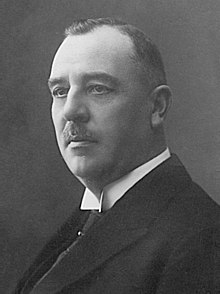Rahvuslik Keskerakond


The National Center Party ( Estonian Rahvuslik Keskerakond - RKE) was a center-right - Party in the first half of the 1930s in Estonia . It was created in 1931/32 as part of several mergers of conservative Estonian parties.
History and program
The National Center Party emerged as a result of the global economic crisis and the consolidation of the Estonian party spectrum in the early 1930s as a merger of four parties from the center-right spectrum.
In October 1931, the conservative, national liberal Estonian People's Party ( Eesti Rahvaerakond ) and the clerical-Protestant Christian People's Party ( Kristlik Rahvaerakond ) merged. On January 29, 1932, the faction of the National Center Party emerged from the union of the two parties with the conservative Estonian Labor Party ( Eesti Tööerakond ). On February 5, 1932, the faction of the small interest party "house owners, merchants, industrialists and other supporters of private property" ( Majaomanikud, kaupmehed, töösturid ja teised eraomandust pooldajad ), which had won three seats in the parliamentary elections in 1929 , joined the group .
In addition to the charismatic Jaan Tõnisson, key politicians of the party in the short period of its existence were the ministers Mihkel Pung , Konstantin Konik , Ado Anderkopp , August Kerem and Hugo Villi Kukke .
Government participation and participation in elections
Since February 1931 incumbent government under the State elders ( Riigivanem ) Konstantin Pats from the "Federation of Farmers" ( Farmers' Assemblies ) resigned when new constellations of power in Parliament (the beginning of 1932 by the union of several political groups and parties Riigikogu ) had formed. The cabinet was replaced by a new government under State Elder Jaan Teemant on February 19, 1932. Due to the upcoming parliamentary elections, this only stayed in office for a short time.
In the parliamentary elections , which took place from May 21 to 23, 1932, the National Center Party received 22.1 percent of the vote. With 23 MPs in the 100-strong Riigikogu , it was the second largest parliamentary group in the 5th legislative period.
From June 1932, the party placed three ministers in the new coalition government of State Elder Karl Einbund ( Põllumeeste Kogud ). The cabinet was replaced in March 1933 by a coalition government under the new state elder Konstantin Päts ( Põllumeeste Kogud ), in which the National Center Party was also represented.
In April 1933, the National Center Party withdrew its ministers from government because of disagreements over economic policy. Jaan Tõnisson of the National Center Party formed a new government on May 18, 1933 under the leadership of the National Center Party . The coalition partner of the RKE was the association of "settlers, small farmers and state tenants" ( Asunikkude, Väikepõllupidajate ja Riigirentnikkude Koondus ).
The government only lasted until October 1933. In a referendum from October 14-16, 1933, the Estonian people adopted a new Estonian constitution . The approval rate was 72.7 percent. The National Center Party had voted against the draft constitution, which it rejected as largely undemocratic. Due to her defeat, she submitted her resignation on October 17, 1933. On October 21, 1933, Konstantin Päts formed a transitional government that was to remain in office until the electoral state and parliament.
Coup in 1934
On March 12, 1934, head of state and government Konstantin Päts from the “ Union of Farmers ” ( Põllumeeste Kogud ) seized power with the help of the Estonian military in a bloodless coup . All parties were banned from activity on September 22, 1934, and parliament was no longer convened from October 3, 1934. Päts ushered in the end of Estonian democracy. His authoritarian rule was replaced in 1940 by the Stalinist occupation of Estonia and the country's annexation into the Soviet Union .
literature
- Sulev Vahtre (Ed.): Eesti Ajalugu. Volume 6: Vabadussõjast Taasiseseisvumiseni. Ilmamaa, Tartu 2005, ISBN 9985-77-142-7 , p. 66 f.
Individual evidence
- ↑ Archived copy ( memento of the original from June 14, 2012 in the Internet Archive ) Info: The archive link was inserted automatically and has not yet been checked. Please check the original and archive link according to the instructions and then remove this notice.